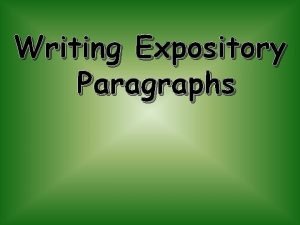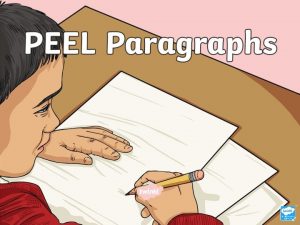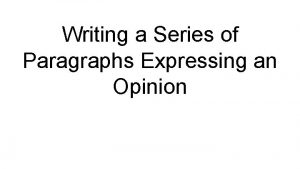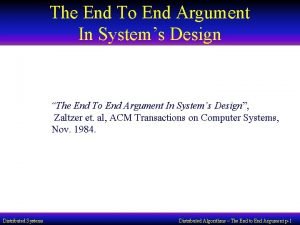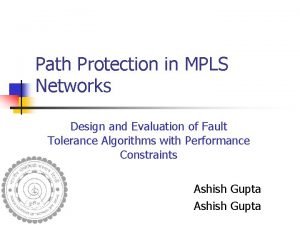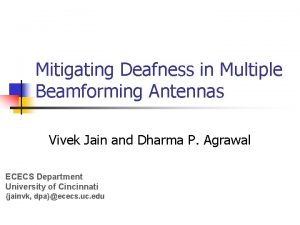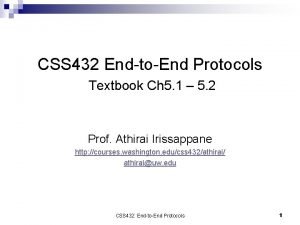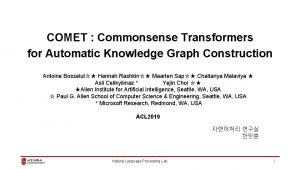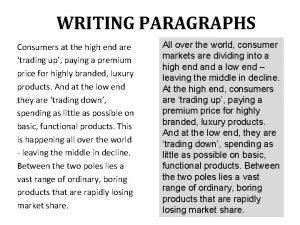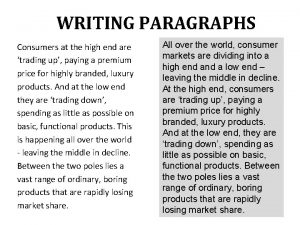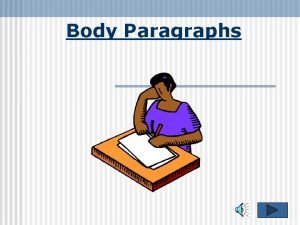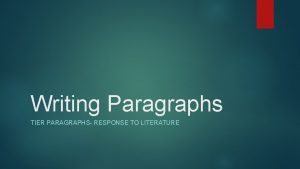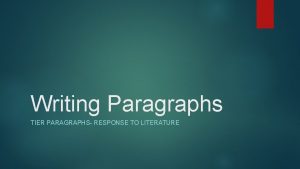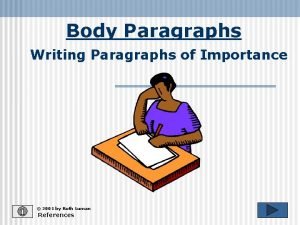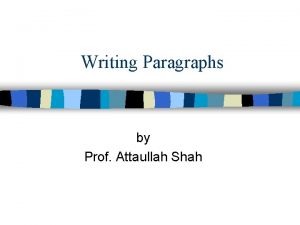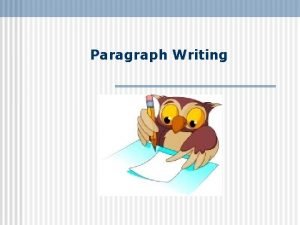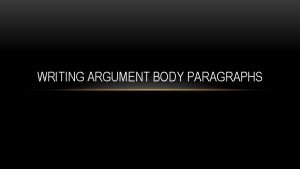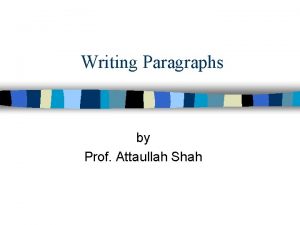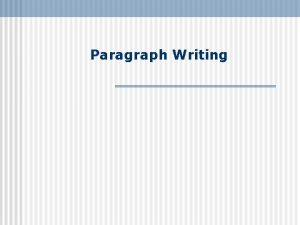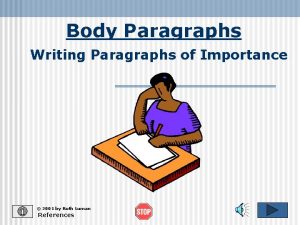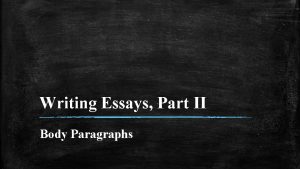WRITING PARAGRAPHS Consumers at the high end are



















- Slides: 19

WRITING PARAGRAPHS Consumers at the high end are ‘trading up’, paying a premium price for highly branded, luxury products. And at the low end they are ‘trading down’, spending as little as possible on basic, functional products. This is happening all over the world - leaving the middle in decline. Between the two poles lies a vast range of ordinary, boring products that are rapidly losing market share. All over the world, consumer markets are dividing into a high end a low end – leaving the middle in decline. At the high end, consumers are ‘trading up’, paying a premium price for highly branded, luxury products. And at the low end, they are ‘trading down’, spending as little as possible on basic, functional products. Between the two poles lies a vast range of ordinary, boring products that are rapidly losing market share.

Paragraph design • Strong paragraphs are typically about one main idea or topic, which is often explicitly stated in a topic sentence. Good topic sentences should always contain both: • (1) a topic – a key sentence, the main subject matter or idea covered in the paragraph. It provides a context and summarises what will follow in the paragraph. • (2) a controlling idea/sub-topic/supporting idea – this idea focuses on the topic by providing direction to the composition; it lends support to the topic sentence.

• Read the following topic sentences. They all contain a topic (in red) and a controlling idea (in purple). When your paragraphs contain a clearly stated topic sentence such as one of the following, your reader will know what to expect and, therefore, understand your ideas better. Examples of topic sentences: • People can avoid plagiarizing by taking certain precautions. • There are several advantages of online education. • Effective leadership requires specific qualities that anyone can develop.

• Demonstrate Your Point • After stating your topic sentence, you need to provide information to prove, illustrate, clarify, and/or exemplify your point. • Ask yourself: • • What examples can I use to support my point? • • What information can I provide to help clarify my thoughts? • • You can do this by adding the following to your paragraph: • Facts, details, reasons, examples • Information from the readings or class discussions • Personal experience, stories, examples from your life, etc.

• Conclude • After illustrating your point with relevant information, add a concluding sentence. Concluding sentences link one paragraph to the next and provide another device for helping you ensure your paragraph is unified. • They also draw together the information you have presented to elaborate your controlling idea by: • Summarising the point(s) you have made. • Repeating words or phrases from the topic sentence. • Using linking words that indicate that conclusions are being drawn (e. g. , therefore, thus, resulting).

Paragraph design • Your paragraph should have MOVEMENT: the ideas should flow clearly and logically (the second text on the first slide). ‘Movement’ means taking the reader from one sentence to the next in clear, logical steps. • Achieving movement: • 1. use the first sentence to mention sub-topics, which are then picked up in sequence by further sentences; • 2. use time sequence, contrast, list of related points (First, Second, Finally), etc. • 3. use linking words

FOUR ESSENTIAL ELEMENTS OF GOOD PARAGRAPH WRITING All the sentences in a paragraph should relate to one main idea. This is called UNITY. Each sentence must add something useful to the key, topic sentence. The second element is ORDER. Order refers to the way you organise your supporting sentences. Whether you choose chronological order, order of importance, or another logical presentation of detail, a solid paragraph always has a definite organization.

Element 3: COHERENCE. Coherence is the quality that makes your writing understandable. Sentences within a paragraph need to connect to each other and work together as a whole. One of the best ways to achieve coherence is to use transition words/sentence connectors. Element 4: COMPLETENESS. Completeness means a paragraph is welldeveloped. If all sentences clearly and sufficiently support the main idea, then your paragraph is complete.

Sentence Connectors • Connectors and sequence markers are words or phrases which show the relationship between ideas. • The main relationships are: Ø Time Ø Logic (cause, contrast, condition, comparison and concession) Ø Text (addition, summary, paraphrase, example and highlight).

TIME • A. The main words and phrases which signal time relationships are: • Beginning • First/first of all/initially/to start with/the first step/at the first stage • Second/secondly/the second step/at the second stage • Third/thirdly/the third step/at the third stage, etc. • Then/after that • Next/subsequently/the next step/at the next stage • Finally/the final step/at the final stage • End

LOGIC • • The main words and phrases that signal logical relationships are as follows: Cause: therefore/ accordingly/ consequently/ as a consequence/ as a result/ hence (formal)/ thus (formal)/ because of this/ that's why (informal)/ so Contrast: yet/ however/ nevertheless/ still/ but/ even so/ all the same (informal) Conditions: then/ in that case Comparison: similarly/ in the same way Concession: anyway/ at any rate Contradiction: in fact/ actually/ as a matter of fact/ indeed Alternation: instead/alternatively

TEXTUAL RELATIONSHIPS • • Addition: also/ in addition/ moreover/ furthermore/ besides/ too/ overall/ in brief/ in short Summary: to sum up/ then/ overall/ in brief/ in short Conclusion: in conclusion/ finally/ lastly/ to conclude Equivalence: in other words/ that means/ namely/ that is to say Inclusion: for example/ for instance/ say/ such as/ as follows (written)/ e. g. (formal and written) Highlight: in particular/ in detail/ especially/ notably/ chiefly/ mainly Generalization: usually/ normally/ as a rule/ in general/ for the most part/ in most cases/ on the whole Stating the obvious: obviously/ naturally/ of course

COHESION IN WRITING • There are two more ways of cohesion in writing. 1. a linking-back device - a way of relating to something that has previously been mentioned in the text in full. One of the commonest is that repeated nouns become pronouns. e. g. John’s performance last year was above average. HE ("he" refers to John) achieved 20% higher results than average with existing customers.

COHESION IN WRITING • 2. repetition – there are two types of repetition – exact, when we repeat exactly the same words, and parallel repetition, when we use the most appropriate word(s) which best refers to the word in question. v Fluoridation is the deliberate addition of a chemical called fluoride to a town’s water supplies, in order to reduce tooth decay. Fluoride occurs naturally in the drinking water of some towns…

4 Cs • Try to remember the 4 Cs when writing your paragraph/essay: • Clear – writing and expression of ideas (easy to read and understand) • Comprehensive - all the main ideas and arguments are included • Concise – short and precise (no unnecessary repetition) • Correct – accurate, both in content and in language use

KEY TO CORRECTION SYMBOLS Agreement of subject and verb, or adjective and noun e. g. The boy walk to school. /They are goods dogs. • A • N Number (Singular or Plural) e. g. It is one of the best hotel there. • T Tense e. g. The earth had an atmosphere around it. • Sp Spelling e. g. The library was pieceful and quite. • WO Word Order (Subject, Verb, Object, Manner, Place, Time) e. g. The earth is the planet third from the sun. /We went yesterday to the store.

KEY TO CORRECTION SYMBOLS • F (VF) Grammatical form of the word (verb, etc) e. g. I was interesting in that book. / The man ran slow. / They studies science in the morning. • WW Wrong Word e. g. Don’t do the plans for tomorrow. / He raised suddenly to his feet. • P Punctuation e. g. bring the book on Monday / I am studying Economics at the university of belgrade / he was very tired therefore he went to bed • X Unnecessary Word e. g. Good grades they are hard to get. / The earth it is the third planet from the sun.

KEY TO CORRECTION SYMBOLS • Reference e. g. John brought her to their house. It is beautiful. • /? / Sentence is too complicated, unclear or incomplete. • // Parallelism e. g. It is important to study and sleeping enough. • / Wrong Joining e. g. I go to the university everyday. • Wrong Separation e. g. I like to eat every thing.

KEY TO CORRECTION SYMBOLS • Missing word (article, preposition, etc) e. g. We listen music when we feel like it. /We went to hotel on Fifth Avenue. • Wph Wrong phrase, wrong way to say this. e. g. We shall study the part played by the appropriate monetary institutions in securing the capital needed. • Log Illogical e. g. Glass is breakable. Thus, it is usually painted blue. • No Untruth e. g. A franchisee receives the royalty fee from a franchiser. • SC Sentence Construction (grammatically wrong, a number of grammatical problems within the sentence).
 Insidan region jh
Insidan region jh Primary and secondary consumers
Primary and secondary consumers Producers primary consumers secondary consumers
Producers primary consumers secondary consumers Expository paragraph example
Expository paragraph example Peel writing examples
Peel writing examples Series of paragraphs expressing an opinion
Series of paragraphs expressing an opinion Writing body paragraphs
Writing body paragraphs A paragraph is like a hamburger
A paragraph is like a hamburger Stroke volume
Stroke volume Stroke volume ejection fraction
Stroke volume ejection fraction Front end and back end in compiler design
Front end and back end in compiler design Back end compilation
Back end compilation Descendorektostomie
Descendorektostomie End-to-end wireframe parsing
End-to-end wireframe parsing End to end argument
End to end argument End to end accounting life cycle tasks
End to end accounting life cycle tasks Protect
Protect End to end delay
End to end delay End to end
End to end Automatic knowledge graph construction
Automatic knowledge graph construction



